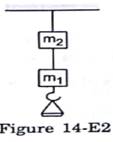The two wires shown in figure (14-E2) are made of the same material which has a breaking stress of 8 × 108 N m-2. The area of cross section of the upper wire is 0.006 cm2 and that of the lower wire is 0.003 cm2. The mass m1 = 10 kg, m2 =20 kg and the hanger is light. (a) Find the maximum load that can be put on the hanger without breaking a wire. Which wire will break first if the load is increased? (b) Repeat the above part if m1 = 10 kg and m2 = 36 kg.

(a) 14 kg, lower
(b) 2 kg, upper
Given, The maximum stress the wire can hold, ![]()
Area of cross section of upper wire, ![]()
Area of cross section of upper wire, ![]()
(a)mass of the block, ![]() and
and ![]() .
.
Let the weight of the load be ![]()
Now, we analyze the weight on each wire.
The lower wire has a total weight of ![]()
Hence, stress on the lower wire is ![]()
For maximum load, we take in the maximum stress that the wire can withstand.
![]()
![]()
The upper wire has a total weight of ![]()
Hence, stress on the lower wire is ![]()
For maximum load, we take in the maximum stress that the wire can withstand.
![]()
![]()
As the lower wire will break when the weight exceeds 14 kg, it will break before the upper wire, which can withstand weights up to 18 kg.
(b)mass of the block, ![]() and
and ![]() .
.
Hence, the lower wire has a total weight of ![]()
Hence, stress on the lower wire is ![]()
For maximum load, we take in the maximum stress that the wire can withstand.
![]()
![]()
Which is the same as previous case.
The upper wire has a total weight of ![]()
Hence, stress on the lower wire is ![]()
For maximum load, we take in the maximum stress that the wire can withstand.
![]()
![]()
Here, the upper wire will break when the weight exceeds 2 kg, it will break before the lower wire, which can withstand weights upto 14 kg.